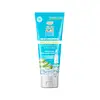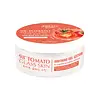What's inside
What's inside
 Key Ingredients
Key Ingredients

 Benefits
Benefits

 Concerns
Concerns

 Ingredients Side-by-side
Ingredients Side-by-side

Water
Skin ConditioningGlycerin
HumectantIsopropyl Palmitate
EmollientCaprylic/Capric Triglyceride
MaskingNiacinamide
SmoothingDimethicone
EmollientSodium Polyacryloyldimethyl Taurate
Emulsion StabilisingAloe Barbadensis Leaf Powder
Skin ConditioningCentella Asiatica Leaf Extract
Skin ConditioningHydrogenated Polydecene
EmollientAluminum Hydroxide
EmollientTocopheryl Acetate
AntioxidantTrehalose
HumectantTitanium Dioxide
Cosmetic ColorantEthylhexylglycerin
Skin ConditioningParfum
MaskingTriethoxycaprylylsilane
Trideceth-10
CleansingChlorphenesin
AntimicrobialMenthol
MaskingCalcium Pantothenate
Sodium Ascorbyl Phosphate
AntioxidantPyridoxine Hcl
Skin ConditioningMaltodextrin
AbsorbentSodium Starch Octenylsuccinate
AbsorbentSilica
AbrasiveWater, Glycerin, Isopropyl Palmitate, Caprylic/Capric Triglyceride, Niacinamide, Dimethicone, Sodium Polyacryloyldimethyl Taurate, Aloe Barbadensis Leaf Powder, Centella Asiatica Leaf Extract, Hydrogenated Polydecene, Aluminum Hydroxide, Tocopheryl Acetate, Trehalose, Titanium Dioxide, Ethylhexylglycerin, Parfum, Triethoxycaprylylsilane, Trideceth-10, Chlorphenesin, Menthol, Calcium Pantothenate, Sodium Ascorbyl Phosphate, Pyridoxine Hcl, Maltodextrin, Sodium Starch Octenylsuccinate, Silica
Solanum Lycopersicum Fruit Extract
AntioxidantWater
Skin ConditioningGlycerin
HumectantPropylene Glycol
HumectantGlyceryl Acrylate/Acrylic Acid Copolymer
HumectantSodium Hyaluronate
HumectantButylene Glycol
HumectantGlyceryl Stearate
EmollientPEG-100 Stearate
Stearic Acid
CleansingButyrospermum Parkii Butter
Skin ConditioningCarbomer
Emulsion StabilisingDimethicone
EmollientTriethanolamine
BufferingPhenoxyethanol
PreservativeChlorphenesin
AntimicrobialSorbitan Sesquioleate
EmulsifyingCaprylyl Glycol
EmollientParfum
MaskingPolysorbate 60
EmulsifyingDisodium EDTA
Panthenol
Skin ConditioningTocopheryl Acetate
AntioxidantAscorbic Acid
AntioxidantSolanum Lycopersicum Fruit Extract, Water, Glycerin, Propylene Glycol, Glyceryl Acrylate/Acrylic Acid Copolymer, Sodium Hyaluronate, Butylene Glycol, Glyceryl Stearate, PEG-100 Stearate, Stearic Acid, Butyrospermum Parkii Butter, Carbomer, Dimethicone, Triethanolamine, Phenoxyethanol, Chlorphenesin, Sorbitan Sesquioleate, Caprylyl Glycol, Parfum, Polysorbate 60, Disodium EDTA, Panthenol, Tocopheryl Acetate, Ascorbic Acid
 Reviews
Reviews

Ingredients Explained
These ingredients are found in both products.
Ingredients higher up in an ingredient list are typically present in a larger amount.
Chlorphenesin is a synthetic preservative. It helps protect a product against bacteria in order to extend shelf life. In most cases, Chlorphenesin is paired with other preservatives such as phenoxyethanol and caprylyl glycol.
Chlorphenesin is a biocide. This means it is able to help fight the microorganisms on our skin. It is also able to fight odor-releasing bacteria.
Chlorphenesin is soluble in both water and glycerin.
Studies show Chlorphenesin is easily absorbed by our skin. You should speak with a skincare professional if you have concerns about using Chlorphenesin.
Learn more about ChlorphenesinDimethicone is a type of synthetic silicone created from natural materials such as quartz.
What it does:
Dimethicone comes in different viscosities:
Depending on the viscosity, dimethicone has different properties.
Ingredients lists don't always show which type is used, so we recommend reaching out to the brand if you have questions about the viscosity.
This ingredient is unlikely to cause irritation because it does not get absorbed into skin. However, people with silicone allergies should be careful about using this ingredient.
Note: Dimethicone may contribute to pilling. This is because it is not oil or water soluble, so pilling may occur when layered with products. When mixed with heavy oils in a formula, the outcome is also quite greasy.
Learn more about DimethiconeGlycerin is already naturally found in your skin. It helps moisturize and protect your skin.
A study from 2016 found glycerin to be more effective as a humectant than AHAs and hyaluronic acid.
As a humectant, it helps the skin stay hydrated by pulling moisture to your skin. The low molecular weight of glycerin allows it to pull moisture into the deeper layers of your skin.
Hydrated skin improves your skin barrier; Your skin barrier helps protect against irritants and bacteria.
Glycerin has also been found to have antimicrobial and antiviral properties. Due to these properties, glycerin is often used in wound and burn treatments.
In cosmetics, glycerin is usually derived from plants such as soybean or palm. However, it can also be sourced from animals, such as tallow or animal fat.
This ingredient is organic, colorless, odorless, and non-toxic.
Glycerin is the name for this ingredient in American English. British English uses Glycerol/Glycerine.
Learn more about GlycerinParfum is a catch-all term for an ingredient or more that is used to give a scent to products.
Also called "fragrance", this ingredient can be a blend of hundreds of chemicals or plant oils. This means every product with "fragrance" or "parfum" in the ingredients list is a different mixture.
For instance, Habanolide is a proprietary trade name for a specific aroma chemical. When used as a fragrance ingredient in cosmetics, most aroma chemicals fall under the broad labeling category of “FRAGRANCE” or “PARFUM” according to EU and US regulations.
The term 'parfum' or 'fragrance' is not regulated in many countries. In many cases, it is up to the brand to define this term.
For instance, many brands choose to label themselves as "fragrance-free" because they are not using synthetic fragrances. However, their products may still contain ingredients such as essential oils that are considered a fragrance by INCI standards.
One example is Calendula flower extract. Calendula is an essential oil that still imparts a scent or 'fragrance'.
Depending on the blend, the ingredients in the mixture can cause allergies and sensitivities on the skin. Some ingredients that are known EU allergens include linalool and citronellol.
Parfum can also be used to mask or cover an unpleasant scent.
The bottom line is: not all fragrances/parfum/ingredients are created equally. If you are worried about fragrances, we recommend taking a closer look at an ingredient. And of course, we always recommend speaking with a professional.
Learn more about ParfumTocopheryl Acetate is AKA Vitamin E. It is an antioxidant and protects your skin from free radicals. Free radicals damage the skin by breaking down collagen.
One study found using Tocopheryl Acetate with Vitamin C decreased the number of sunburned cells.
Tocopheryl Acetate is commonly found in both skincare and dietary supplements.
Learn more about Tocopheryl AcetateWater. It's the most common cosmetic ingredient of all. You'll usually see it at the top of ingredient lists, meaning that it makes up the largest part of the product.
So why is it so popular? Water most often acts as a solvent - this means that it helps dissolve other ingredients into the formulation.
You'll also recognize water as that liquid we all need to stay alive. If you see this, drink a glass of water. Stay hydrated!
Learn more about Water